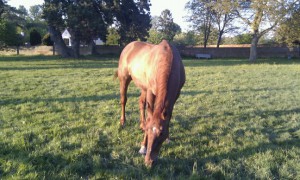The wet and cold of winter is finally coming to an end and you have been given permission to turn your horse out onto their summer grazing paddocks, which are full of glorious green grass, what could be better?
Well, while grass can be a fantastic nutrient source for your horse, lush spring grass can cause problems for some, especially those with metabolic disorders or horses that have had restricted grazing over the winter.
In warm, damp and sunny weather, spring grasses are able to accumulate high levels of non-structural carbohydrates, otherwise known as NSCs. NSCs found in grass can be split into sugars (fructose, sucrose and glucose), starches and fructans (chains of fructose). NSC levels will vary due to environmental and soil conditions, and the stage of plant growth.
Eating large amount of these NSCs can be a risk factor for several digestive and metabolic problems.
NSCs are produced through photosynthesis- the process by which plants use sunlight energy to produce sugars. This can only occur during daylight hours, and then is used to fuel growth of the plants overnight. Usually NSC levels are at their highest at 3-4pm, having accumulated throughout the day, and are lowest early in the morning. However, if temperatures are below 4.5 degrees at night, the plant is unable to utilise these NSCs for growth, and so they accumulate.
The young spring grass is likely to contain high levels of NSCs, and contains less fibre than older grass, which makes it very easily palatable, and the horse is likely to eat a lot! Consuming a high number of NSCs, especially if the digestive system is not used to it, can lead to many issues, including upsetting the delicate balance of gut flora, which can result in colic or laminitis. In addition to this, due to the high palatability of the grass, good doers are likely to put on weight! Spring grass can be a particular problem for those who have suffered from laminitis previously, horses with PPID (Cushing’s disease) and EMS, good doers, and those who have gone from a predominately hay diet onto grass, so these horses may need special management when the spring grass flushes.
Even if your horse is not predisposed to laminitis, make any changes to the diet slowly, so if your horse has been on limited grazing all winter, make the change to being on lush pasture gradual. If necessary, restrict grazing, using muzzles, strip graze, or only turn your horse out for a few hours a day until they are used to the grass in their diet
SPRING GRAZING CHECK LIST:
- Slowly introduce your horse to spring grazing
- Monitor your horses weight carefully
- Provide your horse with supplements to help their digestive system cope with the change, such as pre and probiotics, which will support the good bacteria in the hind gut
- Be particularly careful with horses/ponies predisposed to laminitis, including horses with Cushing’s disease (PPID) and IR and EMS.
If the temperature is below 5 ˚C at night, you may want to consider an alternative option to grass turnout (such as extra exercise, turning out in a sand school/ ménage, horse walker). On bright and sunny days, where temperature is warm, consider turning out for a couple of hours in the morning only, where NSC levels in grass are lower. Wearing a muzzle during this time may also be recommended. Monitor your horse for any early signs of laminitis - it is a common misconception that only fat native ponies will suffer from this, in fact any age or breed of horse may be affected.
For any advice or questions you may have, please don't hesitate to reach out to our expert nutrition team. You can call 0800 585525 Monday-Friday 8:30am-5:00pm. Email [email protected], or send us a DM on social media.



